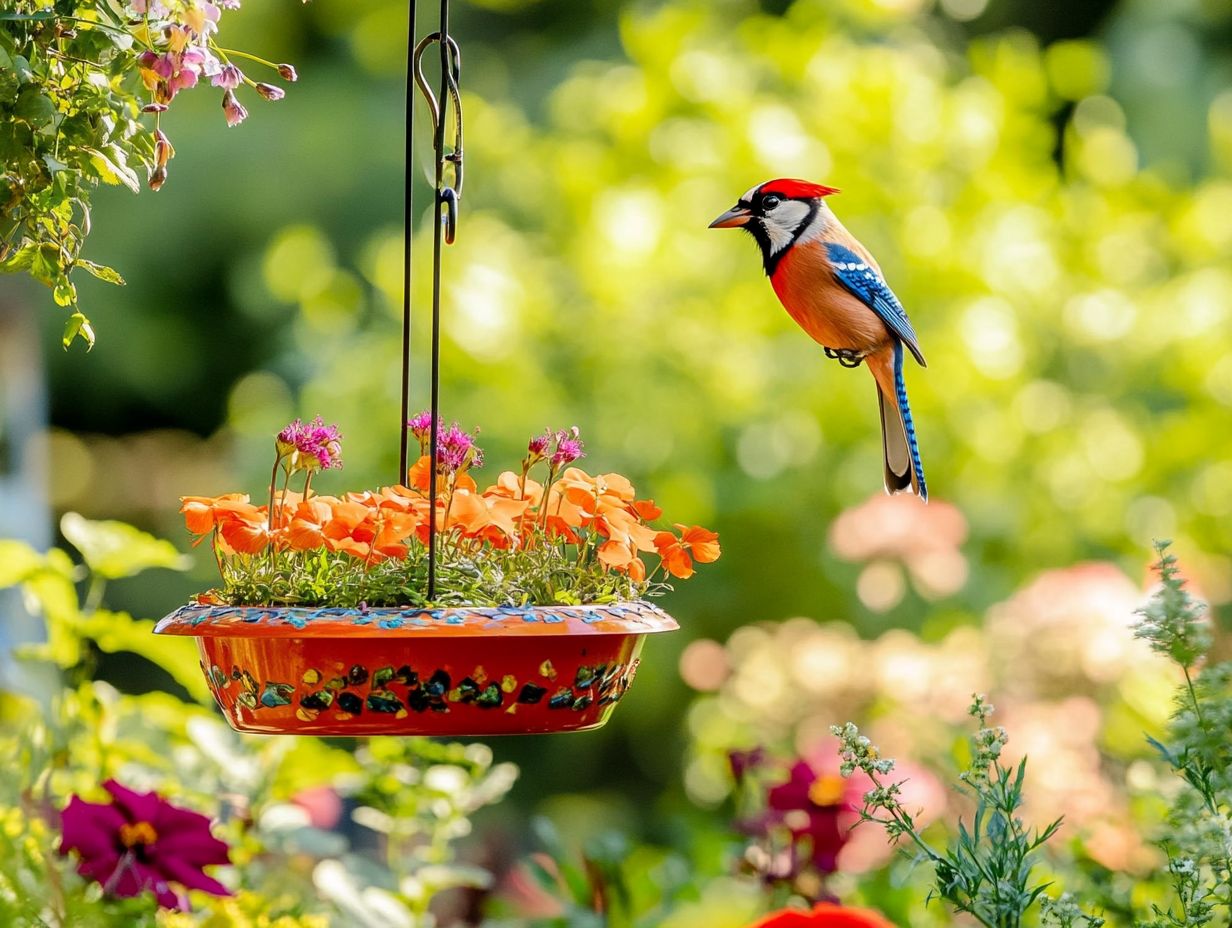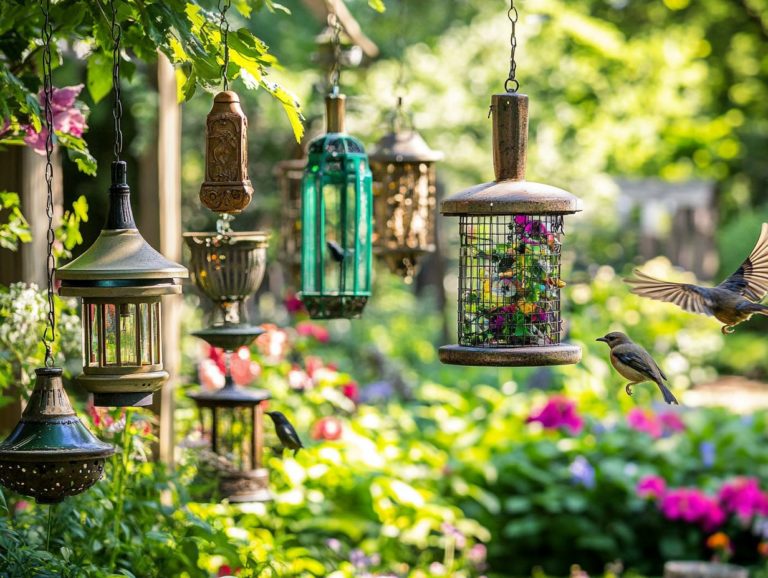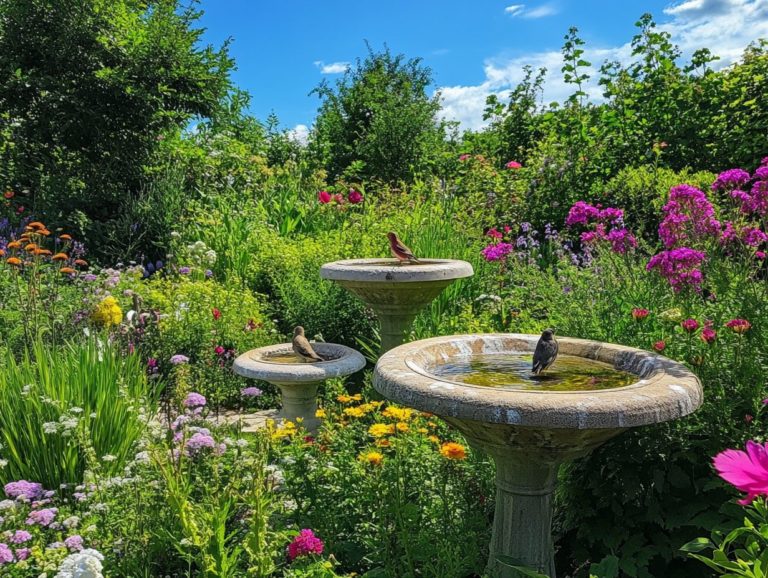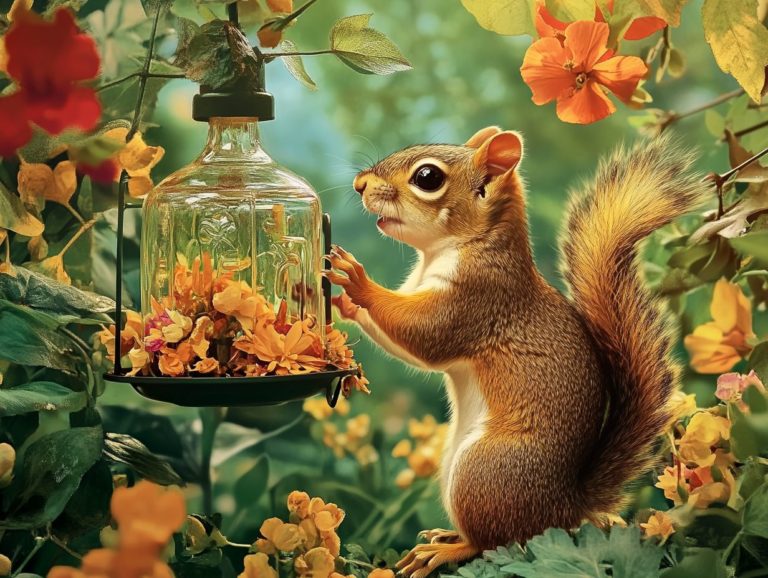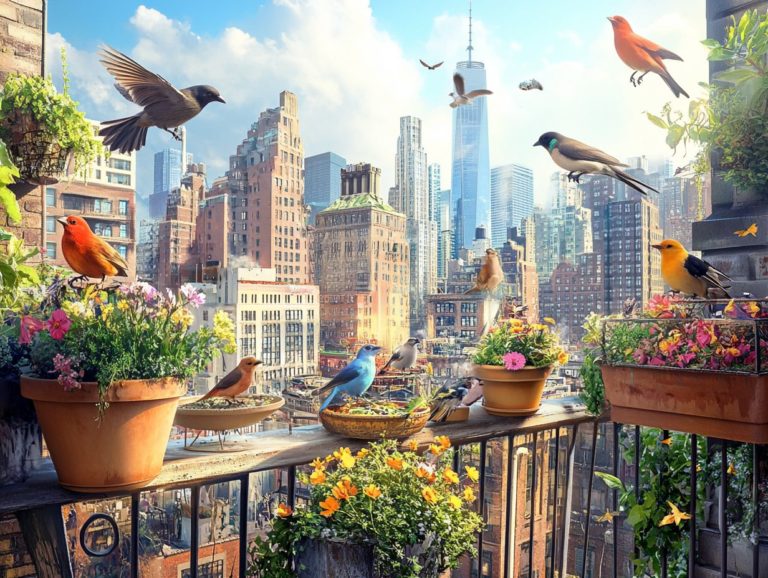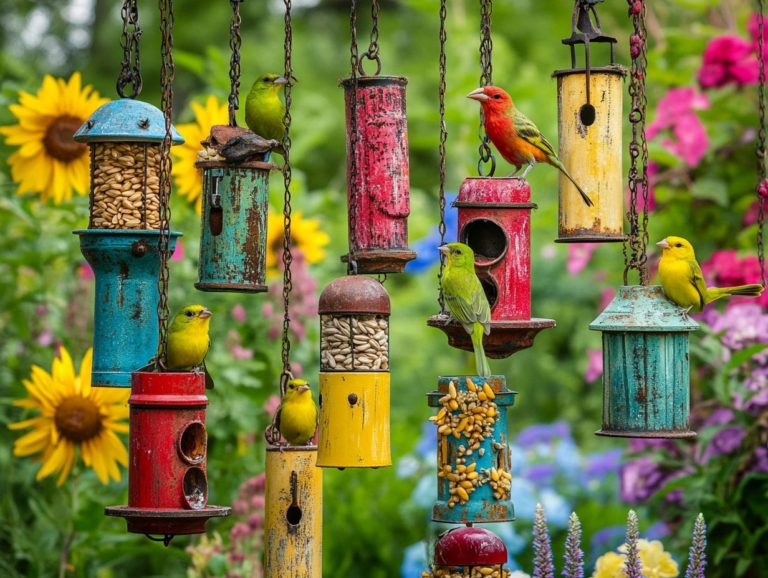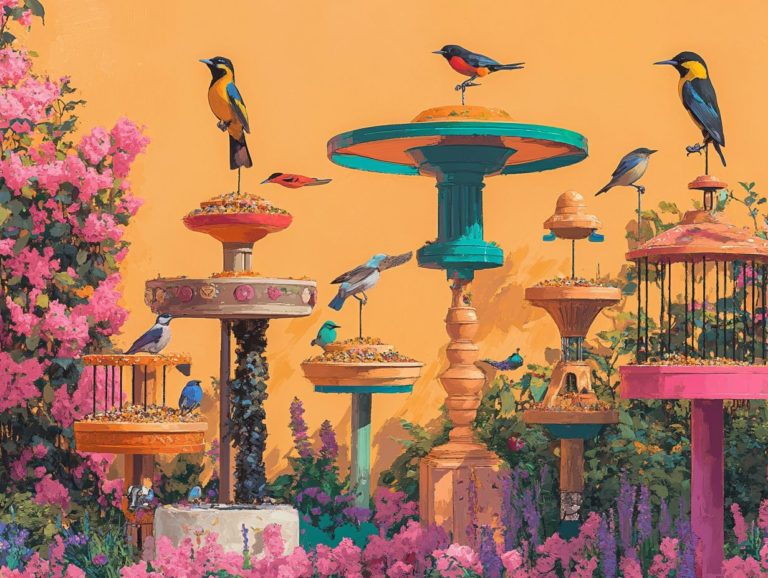Why You Need a Bird Feeder in Your Garden
A bird feeder can transform your backyard into a vibrant sanctuary.
It attracts local bird species and enriches your garden’s ecosystem while supporting wildlife.
Whether you re an experienced birdwatcher or just stepping into this fascinating world, this article delves into the myriad benefits of having a bird feeder and the joy of witnessing birdsong in your garden. From boosting biodiversity to providing essential food sources for birds, including birdseed and nectar for hummingbirds, the advantages are plentiful.
Explore the various types of bird feeders, including nectar feeders and seed feeders. Discover tips for selecting the perfect one for your outdoor space. You ll also find guidance on how to set up and maintain your feeder effectively, including feeding tips for winter and summer. Get ready to meet common birds, such as goldfinches and hummingbirds, that are likely to visit, turning your garden into a lively hub of activity.
Experience the magic of nature right in your backyard!
Contents
Key Takeaways:
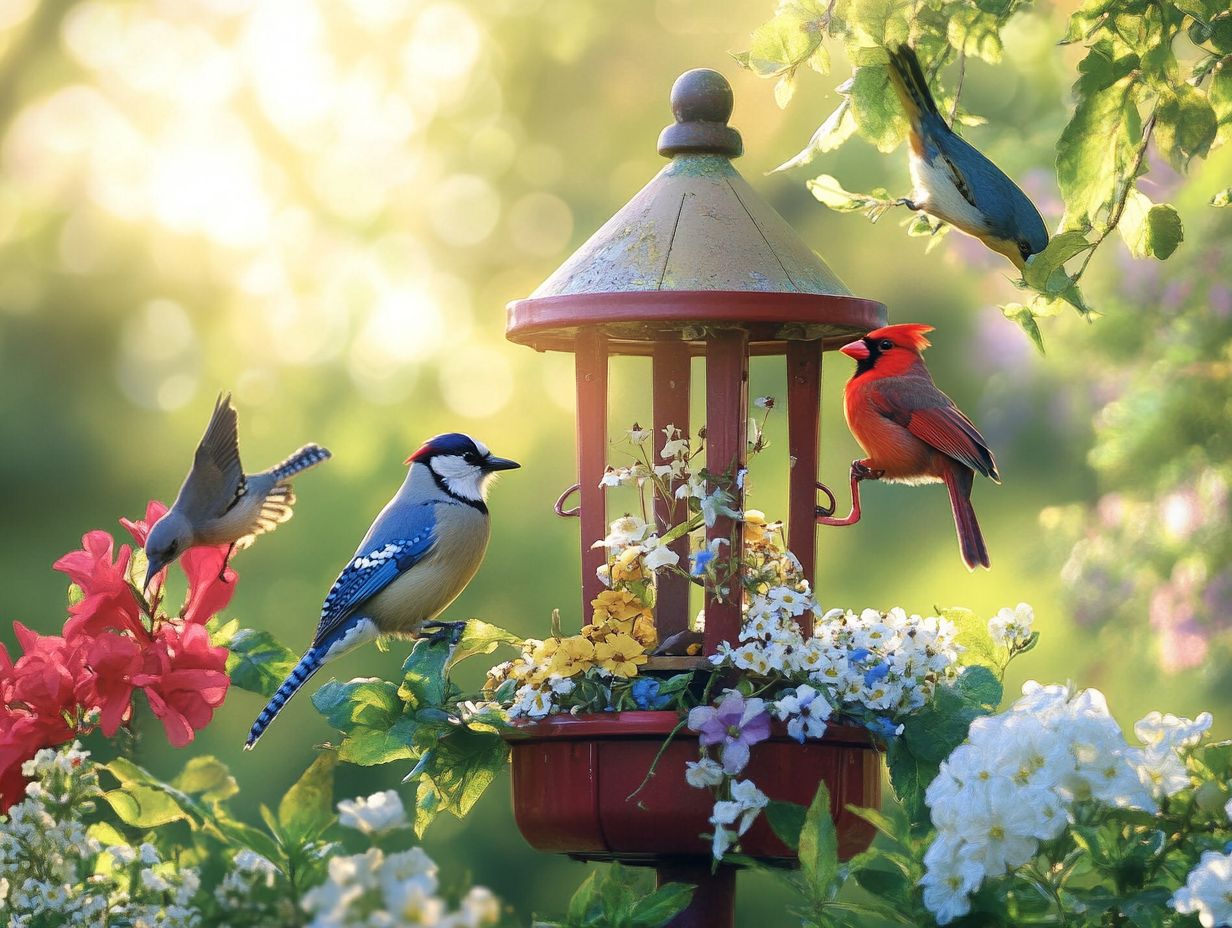
- Attract and support local bird species, including insectivores, by having a bird feeder in your garden.
- Improve your garden’s ecosystem with a bird feeder, contributing to wildlife observation and conservation efforts.
- Choose the right bird feeder by considering design, features, and placement.
Benefits of Having a Bird Feeder
A bird feeder in your backyard serves as an essential food source during winter and nesting seasons. It also fosters a sense of community around conservation efforts.
By simply feeding the birds, you deepen your connection to nature, promote wildlife observation, and elevate your overall birdwatching experience. This allows you to witness the beauty and diversity of avian behavior right from the comfort of your home.
Attracting and Supporting Local Bird Species
Attracting local bird species to your backyard feeder begins with understanding their unique feeding preferences and natural habitat requirements. Native plants provide seeds and berries that many birds love. They also create an inviting environment where birds feel safe.
For example, sunflower seeds are a beloved treat for finches, while suet cakes can draw in woodpeckers and nuthatches.
By incorporating a variety of feeders filled with diverse offerings like nectar for hummingbirds or mealworms for bluebirds you can entice a wide range of species.
Implementing feeding guidelines is vital for maintaining a healthy bird population. Keeping feeders clean and well-stocked minimizes the risk of bird diseases, ensuring that these charming creatures flourish in your garden.
Positive Impact on Garden Ecosystem
The presence of bird feeders in your garden fosters a symbiotic relationship with local wildlife. This positively impacts the ecosystem by enhancing pollination and providing natural food sources for a variety of birds.
As these feeders attract different species, they savor the nourishment you offer and play a crucial role in pollinating your flowers and plants. This interaction helps maintain diverse and healthy bird populations, which supports a flourishing garden ecosystem.
Watching these feathered visitors can deepen your appreciation for nature, creating an inviting space for family and friends to enjoy the sights and sounds of wildlife. The diverse array of birds serves as indicators of environmental health, reflecting the overall condition of your surroundings.
Start your birdwatching journey today and bring the beauty of nature closer to home!
Types of Bird Feeders
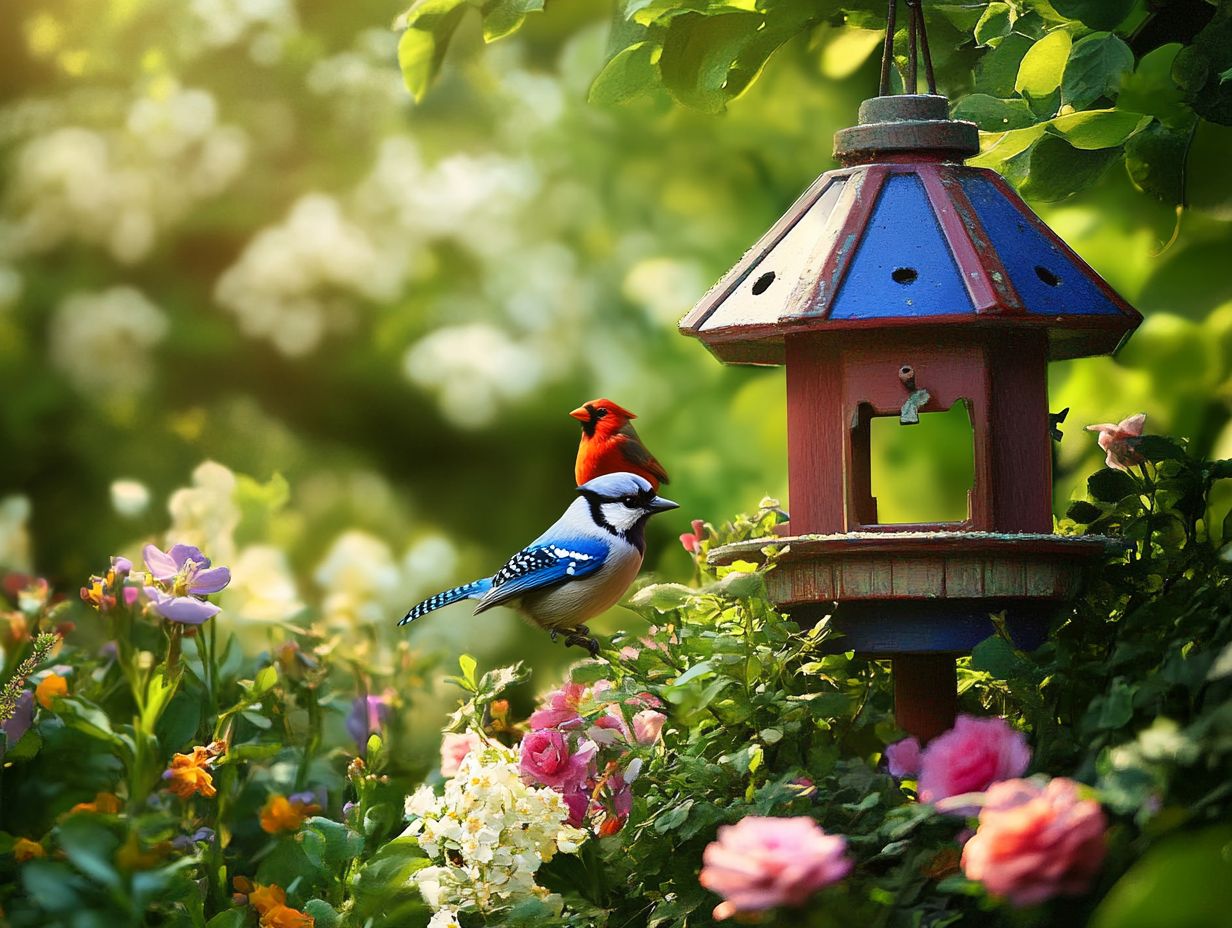
When selecting bird feeders for your outdoor oasis, you’ll discover a range of options tailored to different bird species. From seed feeders to nectar feeders, each type requires its own unique maintenance and cleaning routines.
This attention to detail is essential for keeping the feeders in top shape and for ensuring the safety and well-being of your feathered visitors.
Different Designs and Features
Various bird feeder designs cater to a wide array of bird species, from delightful hummingbirds to vibrant goldfinches. Knowing what makes each feeder special can significantly elevate your birdwatching experience.
For example, feeders with multiple feeding ports allow several birds to dine at once, minimizing competition and attracting a larger variety of species. The choice of materials like wood, metal, or plastic affects durability and ease of cleaning, as well as the aesthetic charm of your garden.
Feeder size and depth are also crucial for attracting different birds. To attract your desired species, adjust the feeding frequency according to seasonal changes like migration patterns and nesting seasons.
Make sure to fill the feeders regularly to keep our feathered friends returning and to amplify the joy of witnessing these beautiful creatures in their natural dance.
Choosing the Right Bird Feeder for Your Garden
Think about these important factors to find the perfect bird feeder for your backyard: the types of birds you want to attract, the space available in your outdoor area, and any environmental challenges you might face, such as extreme temperatures or the possibility of pests.
Factors to Consider
When selecting a bird feeder, consider the seed types that cater to specific bird species. This ensures food safety and optimal feeding practices for your avian visitors.
For instance, sunflower seeds are a favorite among larger birds like cardinals and jays. Smaller species, such as finches, may prefer special seeds called nyjer. A mix that includes peanuts, millet, and safflower can attract a delightful variety of birds to your yard.
It’s essential to introduce fresh seeds regularly; stale offerings can dissuade visitors or even pose health risks. Keeping your feeders clean prevents disease among bird populations. Routine maintenance, like washing feeders with a mild bleach solution, supports the overall health of your feathered friends.
Setting Up and Maintaining Your Bird Feeder
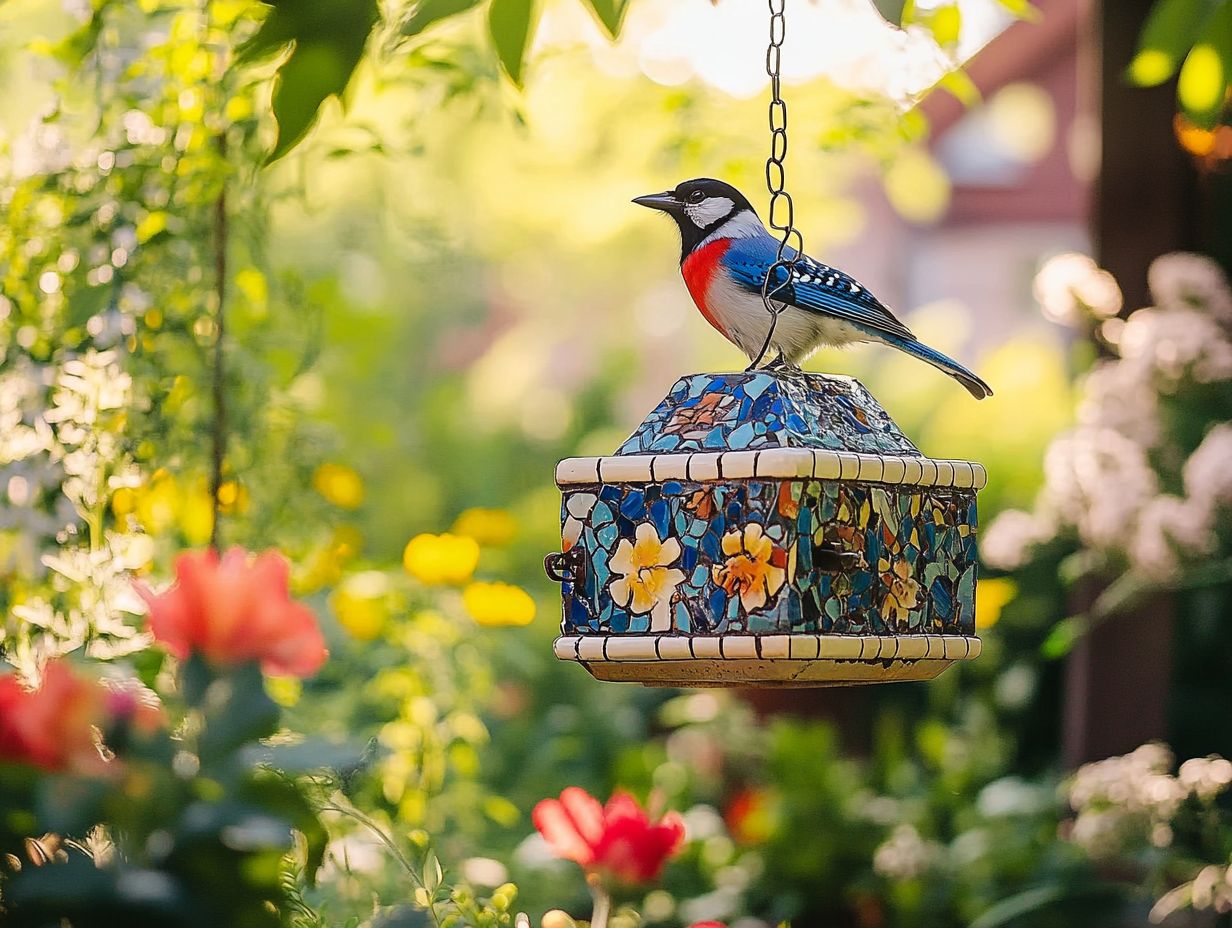
To truly maximize your bird feeder’s effectiveness, consider its placement. Regular maintenance and thorough cleaning techniques create a safe and inviting environment for your feathered friends.
Proper Placement and Cleaning Techniques
The placement of bird feeders in your outdoor space can profoundly influence bird behavior and feeding habits. Regular cleaning is essential for preventing bird diseases.
To maximize visibility, position feeders in areas that provide a clear line of sight for birds while offering protection from potential predators. An ideal spot is close to trees or shrubs that give birds perching opportunities, ensuring there’s an open area around the feeder for safe access.
Different types of feeders, such as tube or platform feeders, require specific placements. For example, platform feeders attract ground feeders and should be situated on or near the ground. In contrast, tube feeders are best hung from hooks or branches.
Regular cleaning of these essential resources ideally every two weeks or more often in wet conditions keeps them disease-free. Use a mixture of hot water and mild soap or a vinegar solution to scrub the feeders. Rinse thoroughly to eliminate any chemical residue.
By following these steps, you can create a thriving and safe feeding environment for birds in your space, enhancing your enjoyment of backyard wildlife.
Common Birds You Can Expect to See at Your Feeder
Get ready to be amazed by the wonderful birds visiting your backyard! When you set up your bird feeder, you’ll encounter a delightful variety of species, including hummingbirds and goldfinches. Particularly during the nesting season and peak urban bird-feeding times, a magical experience unfolds right outside your window.
Identifying and Attracting Local Bird Species
Identifying and attracting local bird species to your backyard starts with understanding their unique feeding preferences. Consider the types of food they crave nectar for hummingbirds and seeds for goldfinches are just the beginning.
By paying attention to their distinct characteristics, such as color, size, and song, you can create an inviting environment that beckons these feathered visitors. Different species are drawn to specific feeders designed to cater to their tastes, like hummingbird feeders filled with a sugar-water mix.
For example, a hummingbird feeder filled with a sugar-water mix attracts those tiny, vibrant birds, while a tube feeder stocked with nyjer seeds is ideal for drawing in finches. (Nyjer seeds are tiny black seeds favored by finches.)
Researching local birds’ seasonal habits is beneficial. This insight allows you to customize your offerings, ensuring you meet their nutritional needs throughout the year.
Frequently Asked Questions
Why do I need a bird feeder in my garden?
Having a bird feeder in your garden not only adds beauty but also provides essential food and shelter for birds. It helps attract a variety of bird species to your garden.
What types of birds can I attract with a bird feeder?
A bird feeder can attract a wide range of birds, including finches, sparrows, chickadees, cardinals, and even hummingbirds. The type of food you offer will determine which birds are drawn to your feeder.
What kind of food should I put in my bird feeder?
There are several types of bird feeders available, each designed for specific foods. Here are some common choices:
- Sunflower seeds
- Nyjer seeds
- Suet
- Mealworms
It’s important to research the types of birds you want to attract and choose a feeder and food accordingly.
Can a bird feeder help control pests in my garden?
Yes! Having a bird feeder can help control pests. Birds are natural predators of many common garden pests, such as aphids and caterpillars. By attracting birds to your garden, you can reduce the need for harmful pesticides.
How often should I refill my bird feeder?
The frequency of refilling your bird feeder depends on the number of birds in your area and how much they are eating. Check and refill your feeder regularly, especially during colder months when birds need extra food for energy.
Can a bird feeder help with bird conservation?
Yes! By providing a reliable food source for birds, a bird feeder can help with conservation efforts. Many bird species face population declines due to habitat loss and food scarcity. Having a feeder in your garden can positively impact their survival.
Don t wait! Set up your bird feeder today and enjoy the beauty of backyard birds!

